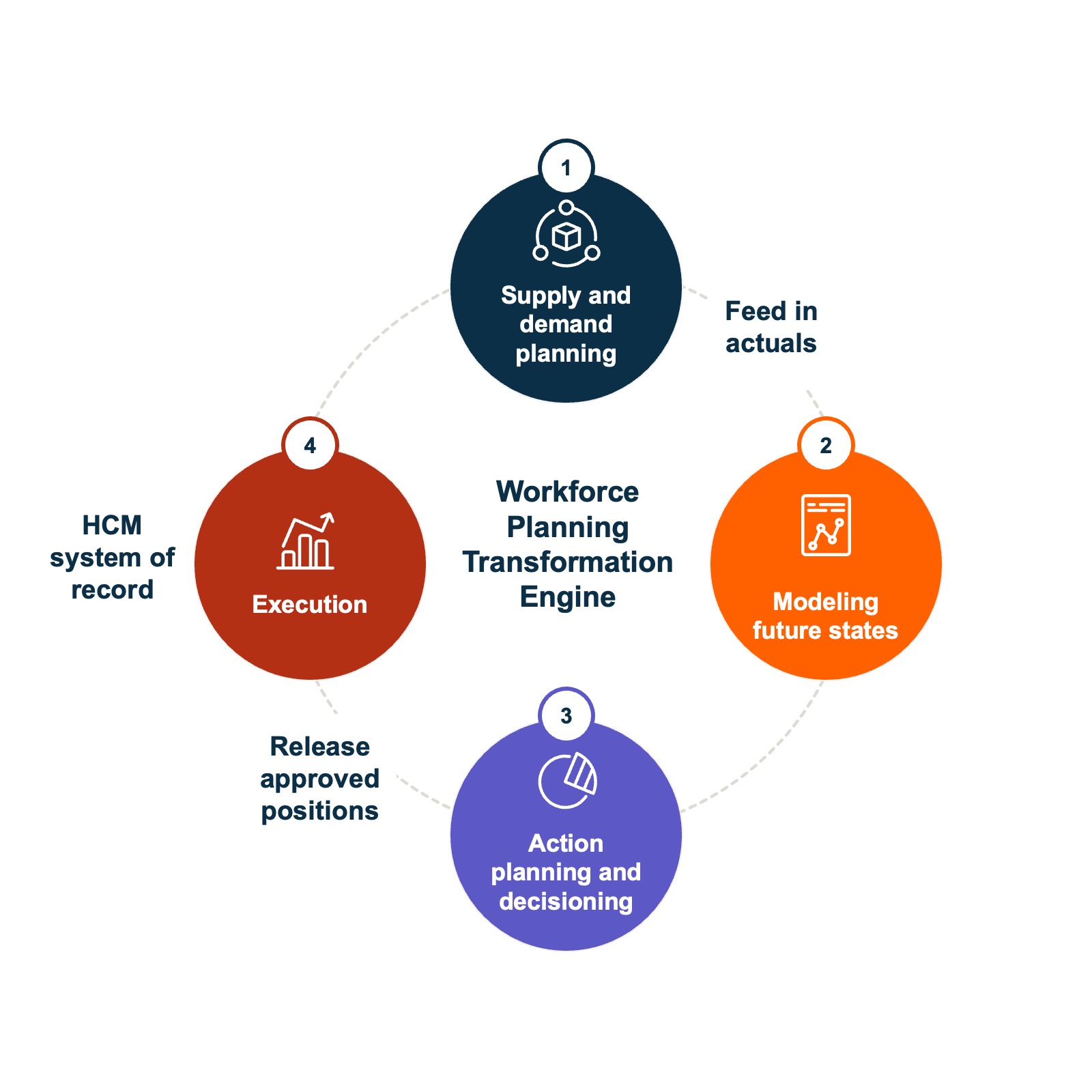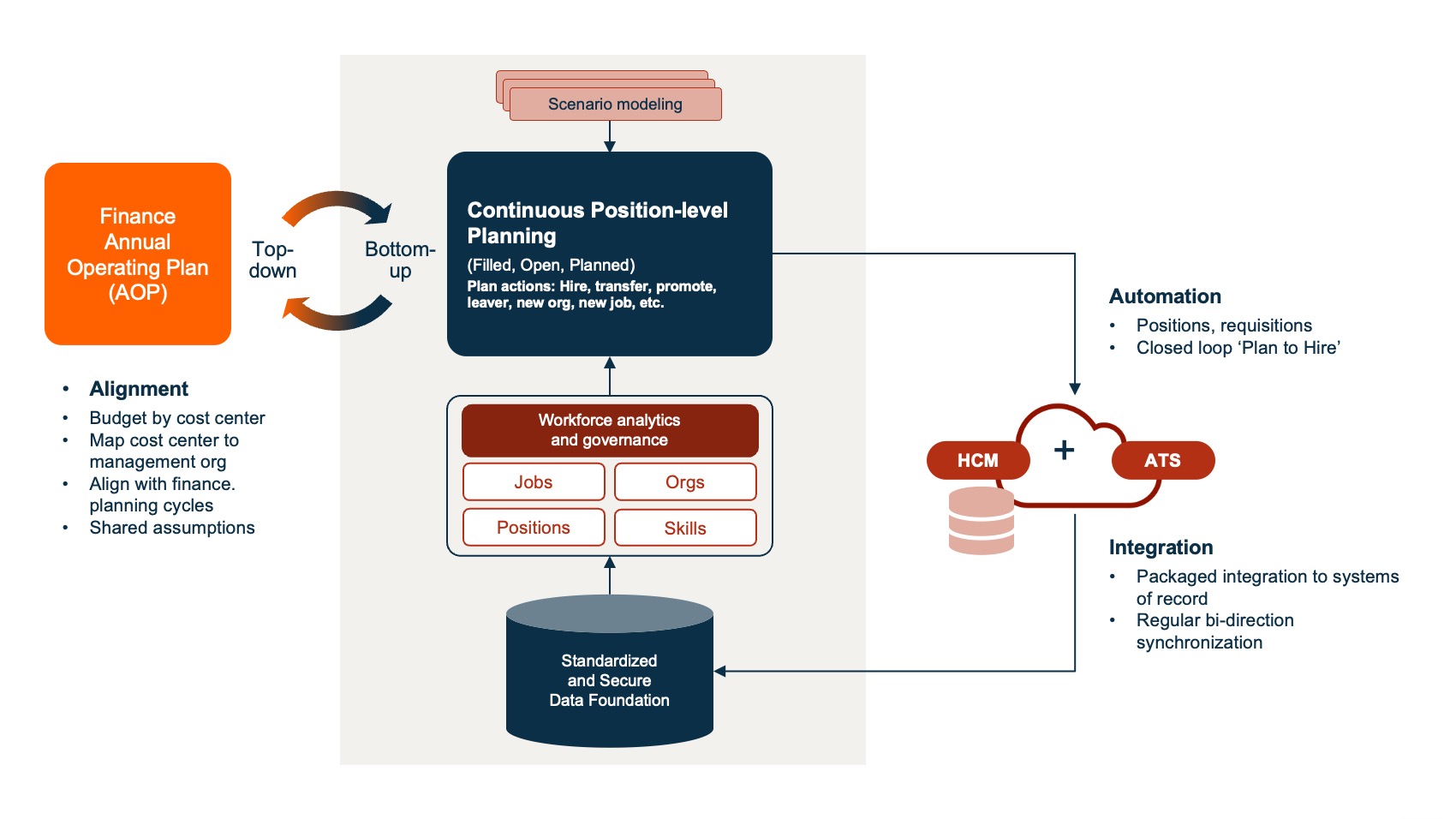“We create positions in our HCM” — it’s a statement I hear frequently from human resource (HR) leaders, and on the surface, makes perfect sense. Your human capital management (HCM) system is the heart of your HR operations, the system of record for your people data. So, why wouldn't you use it to create and manage all positions, including those you plan to hire for in the future?
This common practice, however, often creates a significant and costly paradox. While it seems logical, using an HCM system for workforce planning introduces complexity, rigidity, and a fundamental disconnect between HR and finance. The transactional tool designed to be your system of record is being forced to function as a system of decision-making; a role it was never built for.
The downstream chaos of planning in a system of record
Imagine a scenario in which a fast-growing company is in need of more employees. At the start of the year, leadership announces an ambitious plan: “We're hiring 10,000 people!” In response, the HR team diligently enters 10,000 new, unfilled positions into the HCM. The system allows it, and the team has done its job.
Then, the market shifts. A competitor makes a move, a new technology emerges, or a global event disrupts the supply chain. Suddenly, that 10,000 person hiring plan is no longer viable. Now, the organization is left with 10,000 distinct position objects in its HCM system, each needing to be individually managed, adjusted, or closed. The system wasn't designed for this kind of dynamic, "what-if" scenario planning. It was built to execute and track. The consequence is a data management nightmare that consumes countless hours and offers zero visibility into the real-time impact of these changes across the organization.
What practitioners say
Regrettably, this isn't just a hypothetical situation. Spend some time in customer forums or consulting blogs, and the field voices start to converge. The issues are painful and widespread: Regrettably, this isn't just a hypothetical situation. Spend some time in customer forums or consulting blogs, and the field voices start to converge. The issues are painful and widespread:
- Ghost positions and phantom chairs. Employees are terminated, but the positions remain open indefinitely. The system shows headcount that doesn’t exist.
- Headcount reconciliation breakdowns. Ask finance, HR, and recruiting for their headcount number — you’ll often get three different answers.
- Positions without approval. Business users create new slots without finance or HR oversight, leading to creeping headcount that finance can’t reconcile.
- Freeze/close hygiene problems. Should you freeze a position, close it, or mark it unavailable to fill? Many users don’t know, so positions linger, and reports become polluted.
- Recruiting bottlenecks. Talent teams can’t post jobs because positions aren’t approved, or they bypass the HCM system entirely to keep hiring moving.
- Legacy cleanup debt. Thousands of outdated job profiles, duplicates, or obsolete positions clog the system.
- Change fatigue. Even when the system is designed well, adoption slips. Users revert to spreadsheets because they’re faster and more familiar.
What emerges is a picture of systemic friction — not because the HCM system lacks functionality, but because the lived experience of practitioners collides with the theoretical design.
Finance reviews the budget based on the original plan, while HR is bogged down in the administrative task of cleaning up data in the HCM system. The two teams, who should be strategic partners, operate from two different versions of the truth. HCM vendors have tried to patch this gap with spreadsheet-like, mass edit features, but these are mere band-aids. They are an admission that the core platform lacks the flexibility required for true strategic planning.
Why this matters
These issues aren’t just back-office headaches. They hit at the core of how enterprises manage their workforce:
- Reporting credibility is at risk. When headcount numbers don’t align, leaders stop trusting the data.
- Recruiting slows down. Delays in position approval or mismatched requisitions create bottlenecks.
- Finance and HR disconnect. Budgets live in spreadsheets, headcount lives in the HCM system, and no one is confident they’re in sync.
- Operational efficiency suffers. HR teams spend more time cleaning up positions than advising the business.
The irony is that workforce models were meant to provide clarity. Instead, they’ve become a source of noise.

A better way: Separating planning from execution
The best practice isn't to abandon your HCM for position management but to augment it with a dedicated planning platform. This approach introduces a crucial staging area for all future, proposed, and un-budgeted positions.
In a recent meeting I had with a large enterprise, an HR manager asked us, “We create tons of positions in Workday. Are you saying we shouldn’t do that?” My guidance was clear: to stay aligned with finance and maintain one unified workforce plan, stage future and proposed roles in a planning solution and send only approved positions to the HCM system.
By holding planned positions in a flexible staging area like Anaplan, organizations can:
- Model “what-if” scenarios without consequence: Change team sizes, shift hiring across divisions, and see financial impact instantly without cluttering the HCM system.
- Keep the HCM data clean: Reserve your system of record for approved, ready-to-recruit roles — not hypotheticals.
- Put HR in control: Finalize positions on your terms and “release” them to the HCM system when you’re ready.

Anaplan: The bridge between HR and finance
Anaplan provides the critical bridge to solve these botched or overly complex deployments of position management. It doesn't compete with the HCM system; it makes its processes smarter and more effective.
The Anaplan Operational Workforce Planning application brings HR and finance together with the best of both worlds — a smarter way to manage future positions in a system that can handle it. It ensures you have the right governance, control, alignment between different hierarchies, and a unified view of your budget, so you don't have to worry about the cleanup.
It’s time to move from a common practice that creates friction to a best practice that fosters alignment and agility. Stop asking your system of record to do the job of a planning platform.



